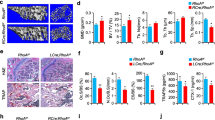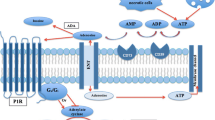Abstract
Bone homeostasis is a finely regulated mechanism involving different molecular pathways including adenosine signaling. The aim of this study is to determine the bone phenotype of adenosine A2B receptor knockout (A2BRKO) mice and to measure their ability to form new bone. Moreover, we analyzed the functionality of osteoclasts and osteoblasts from A2BRKO mice. Microcomputed tomography (μCT) analysis revealed a decrease of bone substance, bone mineral density, and trabecular number in A2BRKO mice compared to the WT mice at the same age. We measured the new bone formation by injecting fluorescent markers: it was reduced in femur and tibia of A2BRKO mice compare to the WT. A2BRKO young mice have fewer osteoblasts and an increase of osteoclasts was measured in the hind limbs of young and adult mice. A2BRKO osteoclasts are also more active in vitro, showing an increase of pit formation in dentin discs. Surprisingly in mature osteoblasts from A2BRKO mice, we measured an increase of calcified matrix production, collagen deposition, and alkaline phosphatase activity. These results demonstrate that A2BR on osteoblasts and osteoclasts regulate bone homeostasis.








Similar content being viewed by others
References
Mediero A, Cronstein BN (2013) Adenosine and bone metabolism. Trends Endocrinol Metab 24(6):290–300
He W, Cronstein BN (2012) Adenosine A1 receptor regulates osteoclast formation by altering TRAF6/TAK1 signaling. Purinergic Signal 8(2):327–337
He W et al (2013) Adenosine regulates bone metabolism via A1, A2A, and A2B receptors in bone marrow cells from normal humans and patients with multiple myeloma. FASEB J 27(9):3446–3454
He W, Wilder T, Cronstein BN (2013) Rolofylline, an adenosine A1 receptor antagonist, inhibits osteoclast differentiation as an inverse agonist. Br J Pharmacol 170(6):1167–1176
Mediero A et al (2012) Adenosine A2A receptor activation prevents wear particle-induced osteolysis. Sci Transl Med 4(135):135ra65
Mediero A et al (2012) Adenosine A(2A) receptor ligation inhibits osteoclast formation. Am J Pathol 180(2):775–786
Mediero A, Perez-Aso M, Cronstein BN (2013) Activation of adenosine A(2A) receptor reduces osteoclast formation via PKA- and ERK1/2-mediated suppression of NFkappaB nuclear translocation. Br J Pharmacol 169(6):1372–1388
Mediero A et al (2015) Direct or indirect stimulation of adenosine A2A receptors enhances bone regeneration as well as bone morphogenetic protein-2. FASEB J 29(4):1577–1590
Carroll SH et al (2012) A2B adenosine receptor promotes mesenchymal stem cell differentiation to osteoblasts and bone formation in vivo. J Biol Chem 287(19):15718–15727
Takedachi M et al (2012) CD73-generated adenosine promotes osteoblast differentiation. J Cell Physiol 227(6):2622–2631
Ciciarello M et al (2013) Extracellular purines promote the differentiation of human bone marrow-derived mesenchymal stem cells to the osteogenic and adipogenic lineages. Stem Cells Dev 22(7):1097–1111
Trincavelli ML et al (2014) Osteoblast differentiation and survival: a role for A2B adenosine receptor allosteric modulators. Biochim Biophys Acta 1843(12):2957–2966
Kang H, Shih YR, Varghese S (2015) Biomineralized matrices dominate soluble cues to direct osteogenic differentiation of human mesenchymal stem cells through adenosine signaling. Biomacromolecules 16(3):1050–1061
Kara FM et al (2010) Adenosine A1 receptors (A1Rs) play a critical role in osteoclast formation and function. FASEB J 24(7):2325–2333
Bakker AD, Klein-Nulend J (2012) Osteoblast isolation from murine calvaria and long bones. Methods Mol Biol 816:19–29
Raggatt LJ, Partridge NC (2010) Cellular and molecular mechanisms of bone remodeling. J Biol Chem 285(33):25103–25108
Noronha-Matos J.B., Correia-de-Sa P. Mesenchymal stem cells ageing: targeting the “purinome” to promote osteogenic differentiation and bone repair. J Cell Physiol. 2016.
Wei W et al (2013) Blocking A2B adenosine receptor alleviates pathogenesis of experimental autoimmune encephalomyelitis via inhibition of IL-6 production and Th17 differentiation. J Immunol 190(1):138–146
Volpini R et al (2003) Medicinal chemistry and pharmacology of A2B adenosine receptors. Curr Top Med Chem 3(4):427–443
Evans BA et al (2006) Human osteoblast precursors produce extracellular adenosine, which modulates their secretion of IL-6 and osteoprotegerin. J Bone Miner Res 21(2):228–236
Le Goff B et al (2010) Role for interleukin-6 in structural joint damage and systemic bone loss in rheumatoid arthritis. Joint Bone Spine 77(3):201–205
de Franca NA et al (2016) Dietary patterns and bone mineral density in Brazilian postmenopausal women with osteoporosis: a cross-sectional study. Eur J Clin Nutr 70(1):85–90
ToRo KOR (2013) A study of risk factors and T-score variability in Romanian women with postmenopausal osteoporosis. Iran J Public Health 42(12):1387–1397
Hallstrom H et al (2013) Long-term coffee consumption in relation to fracture risk and bone mineral density in women. Am J Epidemiol 178(6):898–909
Hallstrom H et al (2006) Coffee, tea and caffeine consumption in relation to osteoporotic fracture risk in a cohort of Swedish women. Osteoporos Int 17(7):1055–1064
Harris SS, Dawson-Hughes B (1994) Caffeine and bone loss in healthy postmenopausal women. Am J Clin Nutr 60(4):573–578
Acknowledgments
This work was supported by grants from the National Institutes of Health (5R01AR068593-02), Clinical and Translational Science Institute (1UL1TR001445-01).
Author information
Authors and Affiliations
Corresponding author
Rights and permissions
About this article
Cite this article
Corciulo, C., Wilder, T. & Cronstein, B.N. Adenosine A2B receptors play an important role in bone homeostasis. Purinergic Signalling 12, 537–547 (2016). https://doi.org/10.1007/s11302-016-9519-2
Received:
Accepted:
Published:
Issue Date:
DOI: https://doi.org/10.1007/s11302-016-9519-2




